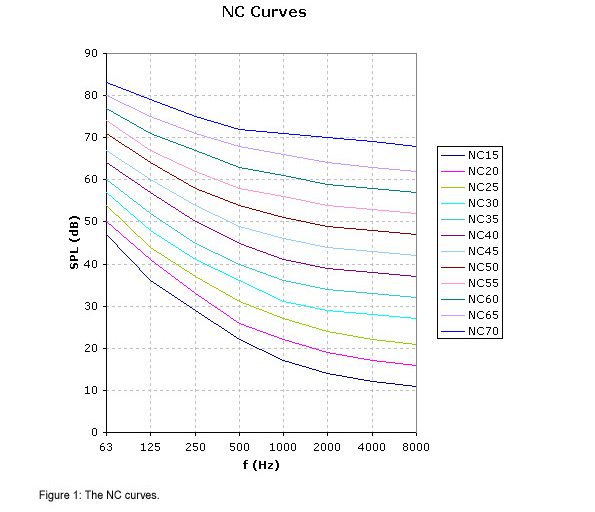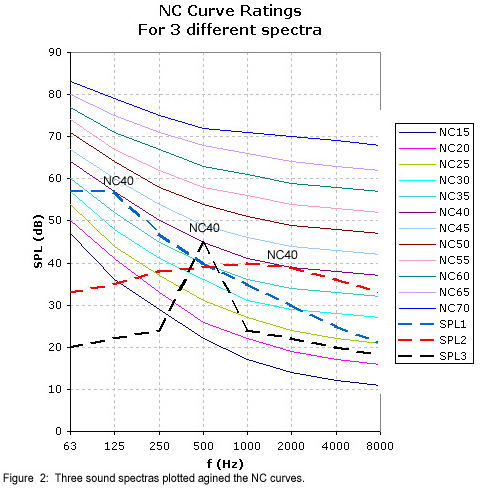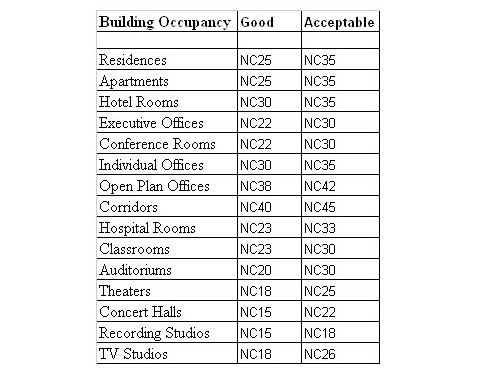
The Noise Criterion provides a single number rating for the sound levels measured or predicted in a room. Noise Criterion curves are used to evaluate existing or predicted noise conditions (generally background noise) indoors. Many specifications for target noise levels and associated noise control measures are often specified based on the NC curves
The curves were derived by Leo L. Beranek from sound level measurements taken in occupied rooms with the mechanical systems operating and from personnel surveys. The curves were published in 1957 and they are still widely used today, although more modern criteria had been developed since. Beranek originally used speech interference as a basis to develop the curves.
The NC curves are octave band curves with a single number rating attached to each of them (see Figure 1). The methodology of determining the NC rating of a particular sound spectrum requires plotting the tested or predicted octave band noise spectrum under assessment against the NC curves and selecting the lowest NC curve with values higher or equal to the ones assessed in all octave bands.
 The NC curves provide both quantitative and qualitative analysis of the indoor noise levels through a single number rating. Unlike the A-weighted sound level, the Noise Criterion provides some spectral information as its level is determined by the level of the highest NC curve that has a tangency point in any octave band with the sound spectrum under evaluation.
The NC curves provide both quantitative and qualitative analysis of the indoor noise levels through a single number rating. Unlike the A-weighted sound level, the Noise Criterion provides some spectral information as its level is determined by the level of the highest NC curve that has a tangency point in any octave band with the sound spectrum under evaluation.

The qualitative assessment of sound using this criterion is not always optimal because there are many different sound spectra with matching NC levels. From Figure 2 one can see that three completely different sound spectra (SPL1, SPL2 and SPL3) could have the same NC level (NC40 in this case).
In terms of qualitative assessment SPL1 is similar to the sound of a constant volume HVAC system; SPL2 is similar to the airflow noise through a diffuser; while SPL3 shows a strong tonal character at 500 Hz. The criterion is not a good reflection of the total amount of sound energy in the spectrum but rather of the energy in the tangency band.
Generally speaking is difficult to compare two sounds based solely on their NC levels without knowing their spectral components.
Another shortcoming of the Noise Criterion is that it is not defined for the octave bands between 63 Hz and 8 kHz. This means the low frequency noise components in the 31.5 Hz and 16 Hz octave bands do not affect the NC value. Noise in these frequency bands are usually associated with structure borne noise and airflow turbulence noise in ductwork systems that could induce rattling of light fixtures, diffusers etc.
It is our experience that based on this criterion, the threshold where complaints start to build-up is NC 42-43 for open plan offices. Whenever the noise level in the space is above this limit, there is a higher likelihood of complaints from the people occupying the space.
Based on our experience and on data published by others we found that the following NC levels due to mechanical equipment servicing the building, according to the type of occupancy, provide good to acceptable sound environments.

The sound level target has to be carefully selected, as the sound environment in a room is determined by the sum of the noise through all paths to a receiver. There should always be a correlation between the sound level requirements for the mechanical systems and the architectural sound isolation requirements as well as the noise levels of other equipment in the room.
There is no point in designing a low mechanical noise level in a private office for example and then installing a desktop computer and a printer or a projector that generate more noise than the mechanical equipment. The target NC levels should always be carefully selected through the design planning stage of the project to ensure that they are feasible and reasonable.
Although the above levels are recommended as design targets for mechanical engineers, there is no consensus that these levels will provide high listener satisfaction levels. Whenever the sound environment is important stricter design conditions should be used, such as lower than average NC levels, or another background noise level testing method such as Room Criteria (RC), and acoustical consultants retained.
At the time when the Noise Criterion was developed, most HVAC systems were constant-volume systems. For these systems there were relatively few low frequency noise problems because the fan could be selected for optimum mechanical performance. Most of the noise problems originated either along the duct path or at the diffusers. Fan sound was made at frequencies below 500 Hz while diffuser noise was concentrated above 500 Hz. The NC rating and the A-weighted rating are sensitive at changes in sound levels at 500 Hz and above. As such, they tended to have a good correlation with the occupant satisfaction in buildings with constant volume HVAC systems.
When energy conservation became more important in the '80s, variable air volume systems started being designed. As economically acceptable variable frequency drives were not available until the '90s, a damper is used on the supply duct at the exit from the air-handling unit to control the airflow. This design allowed for maximum fan efficiency at full airflow, with the damper fully opened. Since this was not the case most of the time, the fan does not always operate at the maximum efficiency point, generating additional noise. One result of this type of design was that the noise environment in many spaces have a "rumbly" character due to the fan noise and airflow turbulence combined with a lack of mid and high frequency masking noise from the low airflow diffusers.
Although more modern background noise criterion has been developed, many products and contractors still use primarily NC levels.